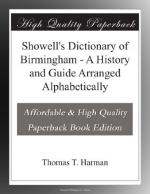SHOWELL’S
Dictionary of Birmingham.
A history and guide,
Arranged Alphabetically,
Containing Thousands of Dates and References to Matters of Interest connected with the Past and Present History of the Town—its Public Buildings, Chapels, Churches and Clubs—its Friendly Societies and Benevolent Associations, Philanthropic and Philosophical Institutions—its Colleges and Schools, Parks, Gardens, Theatres, and Places of Amusement—its Men of Worth and Noteworthy Men, Manufactures and Trades, Population, Rates, Statistics of progress, &c., &c.
* * * * *
Compiled by Thos. T. Harman, Author of “The Local Book of Dates,” “Notes and Records,” &c.,
For the proprietors—
Walter Showell & sons,
CROSS WELLS BREWERY, OLDBURY,
Head Offices: 157, St. Charles street, Birmingham.
* * * * *
Birmingham:
Printed by J.G. Hammond & Co., 136-38 Edmund
Street; and Published by
Cornish brothers, new street.
SHOWELL’S
Dictionary of Birmingham.
NOTES OF BIRMINGHAM IN THE PAST.
Birmingham to the Seventh Century.—We have no record or traces whatever of there being inhabitants in this neighbourhood, though there can be little doubt that in the time of the invasion of the Romans some British strongholds were within a few miles of the place, sundry remains having been found to show that many battles had been fought near here. If residents there were prior to King Edward the Confessor’s reign, they would probably be of Gurth’s tribe, and their huts even Hutton, antiquarian and historian as he was, failed to find traces of. How the name of this our dwelling-place came about, nobody knows. Not less than twelve dozen ways have been found to spell it; a score of different derivations “discovered” for it; and guesses innumerable given as to its origin, but we still wait for the information required.
Birmingham in the Conqueror’s Days.—The Manor was held, in 1066, by Alwyne, son of Wigod the Dane, who married the sister of the Saxon Leofric, Earl of Mercia. According to “Domesday Book,” in 1086, it was tenanted by Richard, who, held, under William Fitz-Ansculf, and included four hides of land and half-a-mile of wood, worth 20s.; there were 150 acres in cultivation, with but nine residents, five villeins, and four bordarers. In 1181 there were 18 freeholders (libere tenentes) in Birmingham cultivating 667 acres, and 35 tenants in demesne, holding 158 acres, the whole value being L13 8s. 2d.
Birmingham in the Feudal Period.—The number of armed men furnished by this town for Edward III.’s wars were four, as compared with six from Warwick, and forty from Coventry.




